
Every new system relies heavily on its early catalog to help determine how successful its infancy period is. And with titles like Super Mario World, F-Zero, Gradius III, Super Castlevania IV and Super Ghouls ‘n Ghosts, the SNES was legitimized. Of course, one can’t talk about the earliest Super Nintendo games without extolling the virtues of one, ActRaiser. Released in North America a whopping 26 years ago, ActRaiser is one of the most beloved early SNES classics of all time. Hell, remove ‘early’ — it’s one of the most memorable SNES hits, period. What makes ActRaiser so great? Well, for starters, developer Quintet was able to accomplish a rather rare feat. Quintet managed to masterfully straddle two genres, blending into an immersive and seamless action adventure for the ages. And that’s just scratching the surface. With the help of Retro Gamer Magazine, let’s delve a little deeper below the surface…
BUT FIRST, A TRIP DOWN MEMORY LANE

January 30, 2006. It was a quiet and idyllic Monday night, just two weeks into my Super Nintendo resurgence. On that fateful night I stopped by the Hollywood Video still lingering in my childhood hometown, hopeful to add more games to my ever growing collection. Any nostalgic memories would be but a bonus.
I ended up buying six games that fine evening. Hollywood Video used to have a Game Crazy hub inside where they sold games from all generations. The SNES selection back in early 2006 was still a bit of a goldmine. Game Crazy did a special buy 2 get 1 free deal for their retro games. I still remember feeling so excited when I spotted ActRaiser on the glass shelf. I actually never played it back in the day so for me this was one of those “redemption” games. My SNES resurrection was a second chance to finally play all those great SNES games I missed out on as a child for one reason or another.



AN ACT OF LOVE
Hey now, ActRaiser 2 wasn’t THAT bad, but we’ll get to that later. Many games have attempted to balance multiple genres, but few did it better than ActRaiser.



DIVERSE LOCALES

FEARSOME BOSSES


FILLMORE
Hovering over the world like the sexy beast that you are, the people down below look to you for their every need: slaying monsters that have invaded their land, building up towns and generally being a source that they can place their faith in. Just remember, with great power comes great responsibility.
Volatile demons of all sizes and shapes come out of the woodwork to thwart your cause. I’ll always be a sucker for tree-based monsters.
Thanks for the helping hand, sucker! Ah, look at that first boss. The Centaur Knight is such a nostalgic sight for anyone who was a Super Nintendo gamer back in the day. I have an extremely soft spot for giant boss sprites and Mr. Centaur definitely left a lasting impression.
Simulation has never been my favorite genre but I quite enjoyed it in ActRaiser. It’s not overly complicated and it adds to the storyline of the game rather well.
Construct the town to prosper and thrive. Be ready to protect it against hostile invaders, at all costs!
Fillmore ain’t done with you yet! A hulking Minotaurus greets you at level’s end. Golden Axe would be proud.
BLOODPOOL
Quintet did such a terrific job with the visuals that you could easily confuse this for a Capcom or Konami title. Bloodpool is arguably the best looking stage of the entire game. I love how atmospheric it looks! It’s particularly perfect to play on a dark and cold late afternoon in November.
Action bit, simulation. Rinse and repeat. Somehow, it never gets boring. The crimson red lake of Bloodpool is such a cool sight. Naturally, it’s been poisoned by monsters and it’s up to you to save the day.
Another memorable moment, a full moon hangs overhead ominously as our hero treks across to enter the horrors that lie deep within this castle…
Initially, this appears to be a run-of-the-mill battle with a wizard warlock. That is, until he reveals his true form! ActRaiser simply captures one’s imagination.
KASANDORA
Kasandora is a scorching desert filled with some incredible music. Composed by Yuzo Koshiro, it’s to no one’s surprise. It sounds almost Star Wars-esque. Hell, the first boss of this world is named Dagoba which is similar to Dagobah (a planet in the Star Wars universe that Yoda called home in his final years).
Digging the Egyptian motif and mummies.
Deranged scorpions litter your path. Eradicate them quickly and it will help take the sting out of things. A massive Pharaoh head guards the end of the level.
AITOS
Things start off in a mountain area with foul rock-throwing trolls. It isn’t long before you catch a lift. The seemingly incessant cloud scrolling here was mind-blowing for 1991 standards.
Inside this cavern you’ll battle terrible winged beasts and a Manda-like serpent.
Protect the people of Aitos at all costs. Back to the hack and slash action, players find themselves buried deep inside a fiery cavern of death and misery.
Samurai spirits [Shodown? -Ed.] attack relentlessly. A demonic fire wheel is your reward at the end of this level.
MARAHNA
Marahna is a humid jungle guarded by a terrible plant beast with plenty of tentacles. The Japanese approve.
Disaster strikes! Tend to the issues properly ASAP.
Beware the grim reaper, who would love nothing more than to claim your soul. Kalia shoots lightning blasts but isn’t as tough as it looks.
NORTHWALL
Northwall is a frozen and frigid country. It’s also one of the hardest stages in the game. Watch out for blue ogres and expect a lot of slipping and sliding around.
Annoying bugger! Your platforming skills and patience will be put to the test.
Bubbles assist you to the top. Hey, didn’t I see that boss in Super Ghouls ‘n Ghosts? Hmmm.
DEATH HEIM
Death Heim is no joke. Prepare for a nasty boss gauntlet. It’s only after beating these six bosses that you are deemed worthy to fight Tanzra.
Tanzra’s final form has a whopping 40 health bars! Good Lord. I always got a kick out of bosses with health that stretches across the entire screen. It never fails to bring back that nostalgic feeling of dread and anxiety as the battle begins!
TWICE AS NICE… OR NOT

ActRaiser 2 was released two years later in November 1993. It’s generally crapped upon, but there is a small camp of folks who believe it’s a bit underrated. But that’s a story (or review) for another time. Few SNES games are as polarizing as ActRaiser 2. It’s a bit ironic given how much the original is universally lionized.
WHAT THE CRITICS SAID
ActRaiser has earned its overwhelmingly positive reputation for good reason. There are so many unoriginal games out there — only a select few are truly unique and stand out from the pack. ActRaiser is one of those games. EGM gave it scores of 9, 9, 9 and 9. Super Play rated it 90%. Critics and fans alike ate it up. It’s widely beloved in retro gaming circles and certainly no respectable Top 100 SNES list is complete without it.


CLOSING THOUGHTS

The action stages are admittedly fairly basic; there’s nothing fancy about them but they hit a very sweet spot for me. There’s a late ’80s-early ’90s action arcade game vibe to the platforming that really works. ActRaiser is of such high quality that I’d still think very highly of it even if it only consisted of the side-scrolling hack and slash bits. But it’s definitely the skillful blending of platforming and simulation that make it truly one of the all-time greats. Town building is simple enough for a sim novice such as myself to get into. The sim parts do well to make me feel that much more connected to the villagers. I always get a kick out of helping the little guys. F’rinstance, resolving the inner conflicts plaguing the people of Bloodpool by playing a special song courtesy of Kasandora stands out as a highlight. See? ActRaiser is proof that music is a unique art form and therapeutic! This masterful alternating between genres is a magical mix that Quintet absolutely crushed out of the park.

Speaking of music, Yuzo Koshiro is at the top of his game here. The soundtrack is absolutely thumping and sounds like it could be something out of a Star Wars film. The boss theme in particular is suitably dramatic and foreboding. It’s some of the best on the SNES. Graphically, ActRaiser is a beautiful looking game. Although the hero’s animation is a bit stiff, I love the various locales and the overall aesthetic of the game. Colors are bright, bold and well defined. There’s not much fault I can find with this game except that it’s way too short for its own good. Just when I feel I am sinking my teeth into the game, it’s over. The action levels are especially short and rather easy (note: the Japanese version is much harder). The action sequences aren’t mind-blowing or anything, but they’re very fun and satisfying (while they last). I love the variety of magic spells at my disposal — it diversifies the action by not being a straight hack and slash affair. I also love being able to repel enemy projectiles with a well-timed sword swing. Little details like that make me a very happy gamer. If for whatever reason you still haven’t played ActRaiser yet… what are you waiting for? It’s easy to see why this is considered one of the all-time SNES greats.
Graphics: 9
Sound: 9.5
Gameplay: 9
Longevity: 7


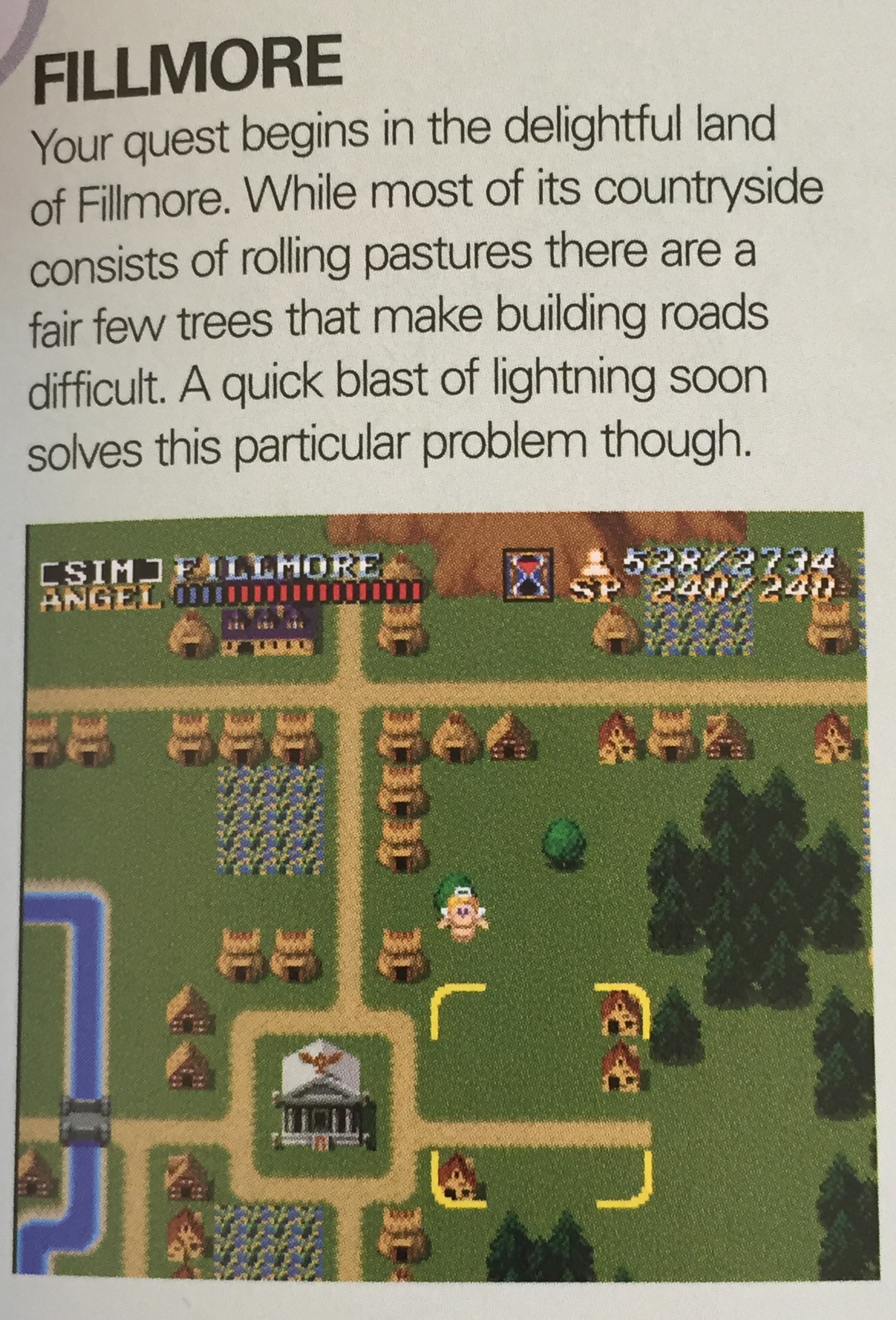

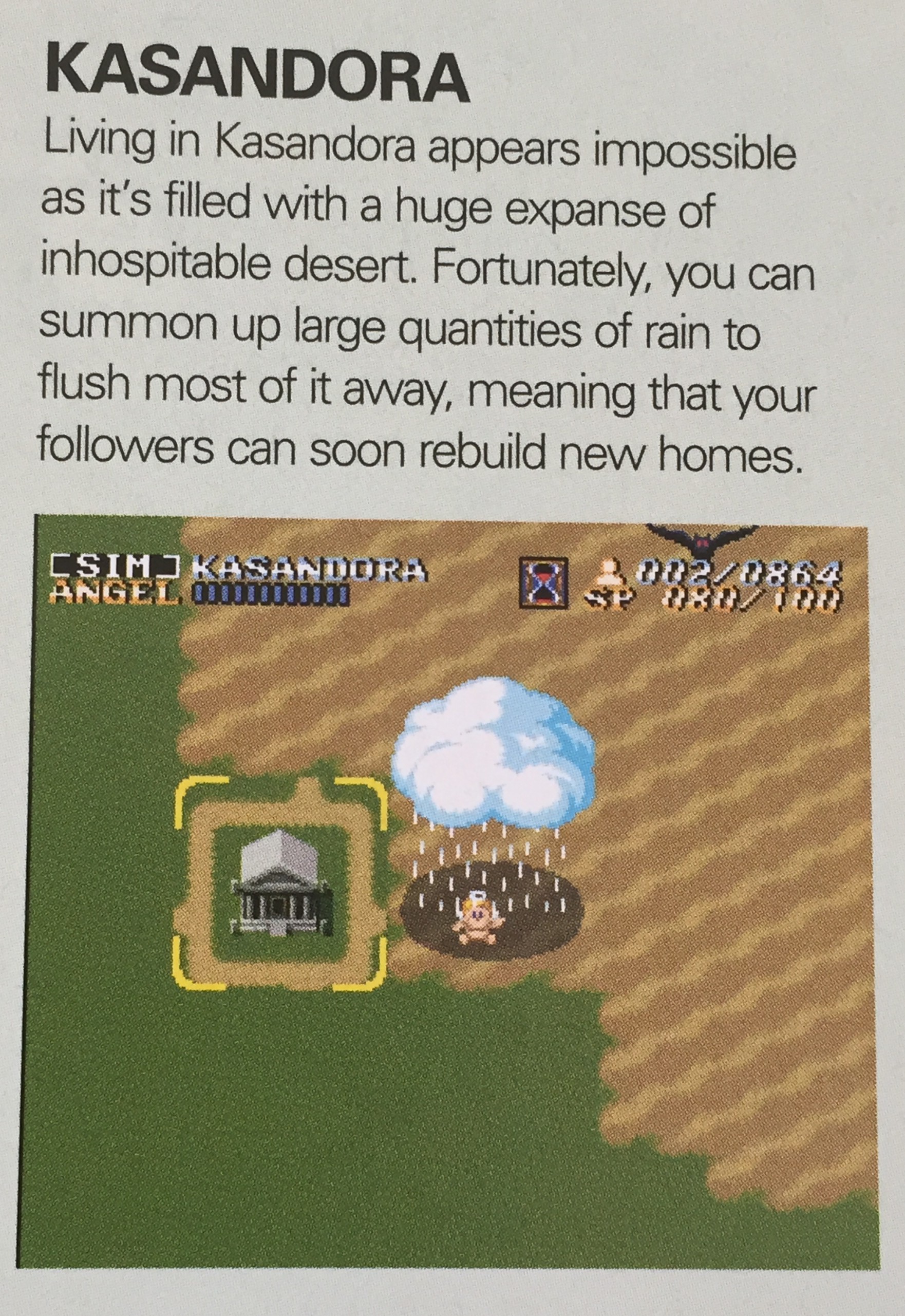










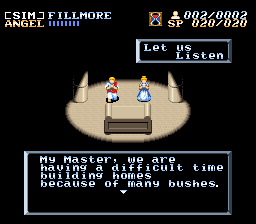



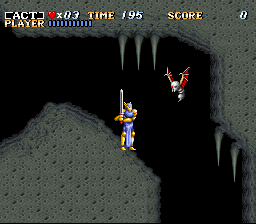


















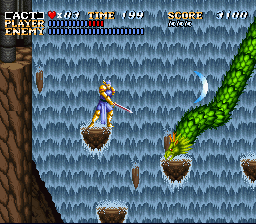
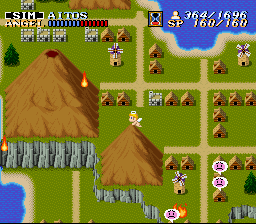

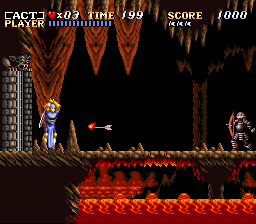





















Errrm, my feelings for Quintet’s inaugural Nintendo 16-bit game are rather complicated, to say the least. I should probably elaborate on why that is.
But to start off so I get it off right away: the whole Actraiser v ActRaiser thing, which I brought up in your ActRaiser 2 review. Did Enix of America not think the original Japanese title design looked good so they decided to capitalize the first “r” instead of leaving it lowercase? They should’ve left the title alone, really.
Anyway, I heard of it and its praises during my teens, and I was curious about it. When the game hit the Nintendo Wii Virtual Console downloadable service back in 2007, and this was before one of my cousins loaned me his SNES console, I thought it was a cool update: it was a perfect opportunity for me to catch up with it, and I liked it for what it was. Like a lot of people, however, I was under the impression that since ActRaiser had been digitally rereleased then the remaining quintet of Quintet’s 16-bit catalogue would follow suit. I mean, it would be a logical conclusion to arrive to, right? Unfortunately, it did not end up being the case, and it wasn’t until several years after the fact that I found out that Quintet became defunct in 2008. So where does the complicated part of my feelings come into play? I’ll get to that.
After I got my SNES console from one of my cousins and I started ordering games from eBay one of the physical carts I contemplated catching up with was SoulBlazer, and upon playing it I ended up adoring it for it’s got a special place in my heart (I love it more than Actraiser/ActRaiser, to be honest), and in the following years I would catch up with other Quintet fare Illusion of Gaia, ActRaiser 2, and Robotrek, then once I started importing Super Famicarts after getting a Retro Duo in 2012 (I use a Super Famicom now since I got it a few years ago) I fulfilled my dream of playing Terranigma albeit as Tenchi Sōzō (which was quite the experience, and my favorite game by Quintet), then a couple years later I imported Actraiser, SoulBlader, and Gaia Gensōki, and in 2015 I got an SNES repro cart of Terranigma. What a time to be alive, to play both versions of the entire Gaia trilogy! =D
It was great to play all these games that I had been curious about playing for a long time, but I could not help but feel that Actraiser/ActRaiser *may* have been a bit too overexposed… maybe a little bit. What I mean is that I’ve seen many lists and countdowns that either have it at the top spot while the other Quintet games are in a lower spot or it was the *only* game on the list while the other games are absent, to which I’m thinking “Are these games not worth acknowledging as well?” or “Have they not played the other Quintet games?”, and I’ve seen the game mentioned endlessly in comments sections as the greatest thing to come out since sliced bread without acknowledging the other games which kind of adversely affected my attitude towards it which I realize isn’t fair but it’s how I felt. I always thought of this game, and this might sound childish, as the spoiled child in Quintet’s sextet of games in that it gets all the special attention while the rest don’t get as much treatment; since it came out Actraiser/ActRaiser has gotten a rerelease and two modified versions of it (a Nintendo Super System arcade version and a version on a mobile phone of all formats) while all the other games were relegated to being SFC/SNES-exclusives. Not enough demand, I suppose; that’s a shame, ’cause it feels like they’ve been neglected by their license holders (I’ve softened over the years ’cause I don’t want to feel like I’m being bitter, as that feeling’s unbecoming, for I know not everyone can afford the luxury to own a Nintendo 16-bit console, but because Actraiser/ActRaiser was the only game that was rereleased of them all the only people who would play it who don’t have an SFC/SNES console are those who own a Nintendo Wii).
It might sound like I don’t like Actraiser/ActRaiser, but that would be far from the truth. I have a fondness for it as my first Quintet game, I like it still (moreso the harder Japanese original) and I appreciate it, it’s just that I’m less receptive of its popularity and that’s why I don’t feel 100% highly about it–more like in the 80’s% range let’s just say.
What I like the most about the game are the microtransaction elements as you’re helping the people evolve and grow as a population whilst fending off against the monsters who are trying to sabotage your efforts in one form or another, and I like the themes that it explores during the proceedings; the action acts are fine (one caveat I have here is that anytime you’re trying to do a consecutive sword swing in midair or while crouching is that the reaction time is not as quick as when you’re doing it while standing, which I’m glad Quintet fixed for ActRaiser 2), but it’s the town-building acts that make for a more involving experience. This game also inhabits one of the best scores by Yuzo Koshiro, whose music I really enjoy in Ys Book I & II and The Revenge of Shinobi and the first two Streets of Rage games for there’s a high operatic feel to its locations, and for a game that was made in 1990 it largely holds up really well visually speaking (that sizzling effect inside the volcano of Aitos is very impressive, the outer regions of Northwall are incredible, and let’s not forget the Anubis statues looming in the distance inside the pyramid of Casandra/Kasandora).
Where it falters in the American version is the difficulty, or lack thereof as Enix tried to “fix” it (a publisher “fixing” a game for a localized release a developer worked so hard to make is rarely a good sign; I’m looking at you, Sony Imagesoft for what you did to System Sacom’s Jerry Boy when it turned into story- and town-free Smart Ball) by reducing the difficulty from the Japanese version, but they may have gone too far in that regard (interestingly, the simulation acts in the Japanese versions are easier as two of its enemies require one less hit point to take out than in the localized version and you don’t have to wait as long if you took damage to heal up; and the pyramid has got an eyeball that was removed in the American version); I can sympathize in certain areas (the first boss in Marana/Marahna was changed dramatically difficulty-wise, going from waiting until its weak spot is unprotected to take action to having its weak spot out in the open the whole time) but a difficulty option to choose from to accurately reflect the earlier version would’ve been appreciated (Professional Mode tries to bring back some of what was in Actraiser in terms of how much damage enemies sustain before biting it but the area designs are still attuned to the American version compared to how they were in the Japanese original so it’s still ActRaiser, only slightly harder and with admittedly better enemy designs than how they appeared during the initial 1990 debut). It is also on the short side which too bad, but is not so bad when I’m in the mood for something short and sweet (the one and only save spot in the game–a distinction shared by fellow Nintendo 16-bit games Lagoon, Obitus, and Brandish 2: The Planet Buster–is a non-issue because of this).
I like this game and it is good fun but I admit to liking ActRaiser 2 (not Quintet’s nadir, in my opinion, that goes to Robotrek but I still like that game enough) more for taking a lot risks in terms of tone, themes, and symbolism and offering more difficulty and challenge, even if it is one of those in-name only sequels and I acknowledge that it’s neither perfect nor for everyone (taking out the sim acts I’ll agree was not a good idea as that formed up the very core of Actraiser/ActRaiser’s being, and what do you get when you take it out? A straight-up action platformer but without any town-building in-between acts); it’s also a glorious-looking game that has H.R. Giger-esque ant enemies (my favorite enemy from that game). But given that ActRaiser 2 has got a password that lets you fight Tanzra as he appeared in the prior game, I’m not sure that was a sound choice given the differing structure of both games, but it IS interesting nonetheless.
To each their own
Thanks for sharing your 2 cents, StarBoy. I agree that I also find the spelling or rather format of writing “ActRaiser” to be a bit funky. That annoyed me with SkyBlazer too. I always want to write it as Sky Blazer but I usually see it as SkyBlazer and that always trips me up a bit. Terranigma is the best of the Quintet SNES efforts and to me that’s not even close. I can understand why you like ActRaiser at an 80% clip rather than 100% because of your own personal feelings.
You’re definitely in the minority in terms of preferring ActRaiser 2 over the original, but as you always say, to each their own.